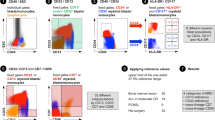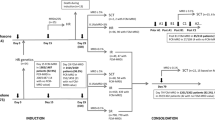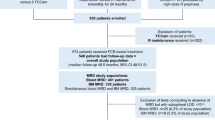Abstract
Rituximab-containing regimens are becoming a therapeutic standard in chronic lymphocytic leukemia (CLL), so that a validation of flow cytometric minimal residual disease (MRD) quantification (MRD flow) in the presence of this antibody is necessary. We therefore compared results obtained by real-time quantitative (RQ)-PCR to MRD flow in 530 samples from 69 patients randomized to receive chemotherapy or chemotherapy plus rituximab. Quantitative MRD levels assessed by both techniques were closely correlated irrespective of therapy (r=0.95). The sensitivity and specificity of MRD flow was not influenced by the presence of rituximab. With 58.9% positive and 26.4% negative samples by both techniques, 85.3% of assessments (452/530) were qualitatively concordant between MRD flow and RQ-PCR. Discordant samples were typically negative by MRD flow and simultaneously positive close to the detection limit of the PCR assays, indicating a higher sensitivity of PCR for very low MRD levels. However, 93.8% of all samples were concordantly classified by both methods using a threshold of 10−4 to determine MRD positivity. MRD flow and PCR are equally effective for MRD quantification in rituximab-treated CLL patients within a sensitivity range of up to 10−4, whereas PCR is more sensitive for detecting MRD below that level.
This is a preview of subscription content, access via your institution
Access options
Subscribe to this journal
Receive 12 print issues and online access
$259.00 per year
only $21.58 per issue
Buy this article
- Purchase on Springer Link
- Instant access to full article PDF
Prices may be subject to local taxes which are calculated during checkout




Similar content being viewed by others
References
Keating MJ, O'Brien S, Albitar M, Lerner S, Plunkett W, Giles F et al. Early results of a chemoimmunotherapy regimen of fludarabine, cyclophosphamide, and rituximab as initial therapy for chronic lymphocytic leukemia. J Clin Oncol 2005; 23: 4079–4088.
Byrd JC, Peterson BL, Morrison VA, Park K, Jacobson R, Hoke E et al. Randomized phase 2 study of fludarabine with concurrent versus sequential treatment with rituximab in symptomatic, untreated patients with B-cell chronic lymphocytic leukemia: Results from Cancer and Leukemia Group B 9712 (CALGB 9712). Blood 2003; 101: 6–14.
Eichhorst BF, Busch R, Hopfinger G, Pasold R, Hensel M, Steinbrecher C et al. Fludarabine plus cyclophosphamide versus fludarabine alone in first-line therapy of younger patients with chronic lymphocytic leukemia. Blood 2006; 107: 885–891.
Bosch F, Ferrer A, Villamor N, Gonzalez M, Briones J, Gonzalez-Barca E et al. Fludarabine, cyclophosphamide, and mitoxantrone as initial therapy of chronic lymphocytic leukemia: high response rate and disease eradication. Clin Cancer Res 2008; 14: 155–161.
Kay NE, Geyer SM, Call TG, Shanafelt TD, Zent CS, Jelinek DF et al. Combination chemoimmunotherapy with pentostatin, cyclophosphamide, and rituximab shows significant clinical activity with low accompanying toxicity in previously untreated B chronic lymphocytic leukemia. Blood 2007; 109: 405–411.
Moreton P, Kennedy B, Lucas G, Leach M, Rassam SM, Haynes A et al. Eradication of minimal residual disease in B-cell chronic lymphocytic leukemia after alemtuzumab therapy is associated with prolonged survival. J Clin Oncol 2005; 23: 2971–2979.
Cheson BD, Bennett JM, Grever M, Kay N, Keating MJ, O'Brien S et al. National cancer institute-sponsored working group guidelines for chronic lymphocytic leukemia: revised guidelines for diagnosis and treatment. Blood 1996; 87: 4990–4997.
Hallek M, Cheson BD, Catovsky D, Caligaris-Cappio F, Dighiero G, Dohner H et al. Guidelines for the diagnosis and treatment of chronic lymphocytic leukemia: a report from the International Workshop on Chronic Lymphocytic Leukemia updating the National Cancer Institute-Working Group 1996 guidelines. Blood 2008; 111: 5446–5456.
Ritgen M, Bottcher S, Stilgenbauer S, Bunjes D, Schubert J, Cohen S et al. Quantitative MRD monitoring identifies distinct GVL response patterns after allogeneic stem cell transplantation for chronic lymphocytic leukemia: results from the GCLLSG CLL3X trial. Leukemia 2008; 22: 1377–1386.
Moreno C, Villamor N, Colomer D, Esteve J, Gine E, Muntanola A et al. Clinical significance of minimal residual disease, as assessed by different techniques, after stem cell transplantation for chronic lymphocytic leukemia. Blood 2006; 107: 4563–4569.
Dreger P, Ritgen M, Bottcher S, Schmitz N, Kneba M . The prognostic impact of minimal residual disease assessment after stem cell transplantation for chronic lymphocytic leukemia: Is achievement of molecular remission worthwhile? Leukemia 2005; 19: 1135–1138.
Milligan DW, Fernandes S, Dasgupta R, Davies FE, Matutes E, Fegan CD et al. Results of the MRC pilot study show autografting for younger patients with chronic lymphocytic leukemia is safe and achieves a high percentage of molecular responses. Blood 2005; 105: 397–404.
Wendtner CM, Ritgen M, Schweighofer CD, Fingerle-Rowson G, Campe H, Jager G et al. Consolidation with alemtuzumab in patients with chronic lymphocytic leukemia (CLL) in first remission--experience on safety and efficacy within a randomized multicenter phase III trial of the German CLL Study Group (GCLLSG). Leukemia 2004; 18: 1093–1101.
Montillo M, Tedeschi A, Miqueleiz S, Veronese S, Cairoli R, Intropido L et al. Alemtuzumab as consolidation after a response to fludarabine is effective in purging residual disease in patients with chronic lymphocytic leukemia. J Clin Oncol 2006; 24: 2337–2342.
del Poeta G, Del Principe MI, Buccisano F, Maurillo L, Capelli G, Luciano F et al. Consolidation and maintenance immunotherapy with rituximab improve clinical outcome in patients with B-cell chronic lymphocytic leukemia. Cancer 2008; 112: 119–128.
Rawstron AC, Kennedy B, Moreton P, Dickinson AJ, Cullen MJ, Richards SJ et al. Early prediction of outcome and response to alemtuzumab therapy in chronic lymphocytic leukemia. Blood 2004; 103: 2027–2031.
Ritgen M, Lange A, Stilgenbauer S, Dohner H, Bretscher C, Bosse H et al. Unmutated immunoglobulin variable heavy-chain gene status remains an adverse prognostic factor after autologous stem cell transplantation for chronic lymphocytic leukemia. Blood 2003; 101: 2049–2053.
Hillmen P, Skotnicki AB, Robak T, Jaksic B, Dmoszynska A, Wu J et al. Alemtuzumab compared with chlorambucil as first-line therapy for chronic lymphocytic leukemia. J Clin Oncol 2007; 25: 5616–5623.
Bottcher S, Ritgen M, Pott C, Bruggemann M, Raff T, Stilgenbauer S et al. Comparative analysis of minimal residual disease detection using four-color flow cytometry, consensus IgH-PCR, and quantitative IgH PCR in CLL after allogeneic and autologous stem cell transplantation. Leukemia 2004; 18: 1637–1645.
Tam CS, O'Brien S, Wierda W, Kantarjian H, Wen S, Do KA et al. Long-term results of the fludarabine, cyclophosphamide, and rituximab regimen as initial therapy of chronic lymphocytic leukemia. Blood 2008; 112: 975–980.
Robak T, Blonski JZ, Gora-Tybor J, Jamroziak K, Dwilewicz-Trojaczek J, Tomaszewska A et al. Cladribine alone and in combination with cyclophosphamide or cyclophosphamide plus mitoxantrone in the treatment of progressive chronic lymphocytic leukemia: report of a prospective, multicenter, randomized trial of the Polish Adult Leukemia Group (PALG CLL2). Blood 2006; 108: 473–479.
Bruggemann M, Droese J, Bolz I, Luth P, Pott C, von Neuhoff N et al. Improved assessment of minimal residual disease in B cell malignancies using fluorogenic consensus probes for real-time quantitative PCR. Leukemia 2000; 14: 1419–1425.
Rawstron AC, Kennedy B, Evans PA, Davies FE, Richards SJ, Haynes AP et al. Quantitation of minimal residual disease levels in chronic lymphocytic leukemia using a sensitive flow cytometric assay improves the prediction of outcome and can be used to optimize therapy. Blood 2001; 98: 29–35.
Rawstron AC, Villamor N, Ritgen M, Bottcher S, Ghia P, Zehnder JL et al. International standardized approach for flow cytometric residual disease monitoring in chronic lymphocytic leukaemia. Leukemia 2007; 21: 956–964.
van der Velden V, Cazzaniga G, Schrauder A, Hancock J, Bader P, Panzer-Grumayer ER et al. Analysis of minimal residual disease by Ig/TCR gene rearrangements: guidelines for interpretation of real-time quantitative PCR data. Leukemia 2007; 21: 604–611.
Hallek M, Fingerle-Rowson G, Fink A, Busch R, Mayer J, Hensel M et al. Immunochemotherapy with fludarabine (F), cyclophosphamide (C), and rituximab (R) (FCR) versus fludarabine and cyclophosphamide (FC) improves response rates and progression-free survival (PFS) of previously untreated patients (pts) with advanced chronic lymphocytic leukemia (CLL). Blood 2008; 112. abstract 325.
Byrd JC, Rai K, Peterson BL, Appelbaum FR, Morrison VA, Kolitz JE et al. Addition of rituximab to fludarabine may prolong progression-free survival and overall survival in patients with previously untreated chronic lymphocytic leukemia: an updated retrospective comparative analysis of CALGB 9712 and CALGB 9011. Blood 2005; 105: 49–53.
Rawstron AC, de Tute R, Jack AS, Hillmen P . Flow cytometric protein expression profiling as a systematic approach for developing disease-specific assays: identification of a chronic lymphocytic leukaemia-specific assay for use in rituximab-containing regimens. Leukemia 2006; 20: 2102–2110.
Bottcher S, Ritgen M, Buske S, Gesk S, Klapper W, Hoster E et al. Minimal residual disease detection in mantle cell lymphoma: Methods and significance of four-color flow cytometry compared to consensus IGH-polymerase chain reaction at initial staging and for follow-up examinations. Haematologica 2008; 93: 551–559.
Krober A, Seiler T, Benner A, Bullinger L, Bruckle E, Lichter P et al. V(H) mutation status, CD38 expression level, genomic aberrations, and survival in chronic lymphocytic leukemia. Blood 2002; 100: 1410–1416.
Dohner H, Stilgenbauer S, Benner A, Leupolt E, Krober A, Bullinger L et al. Genomic aberrations and survival in chronic lymphocytic leukemia. N Engl J Med 2000; 343: 1910–1916.
Wierda W, O'Brien S, Wen S, Faderl S, Garcia-Manero G, Thomas D et al. Chemoimmunotherapy with fludarabine, cyclophosphamide, and rituximab for relapsed and refractory chronic lymphocytic leukemia. J Clin Oncol 2005; 23: 4070–4078.
Acknowledgements
We are grateful to the German CLL Study Group (GCLLSG) and the contributing centers taking care of patients being enrolled in this study. The contribution of the GCLLSG study center (Anne Westermann, Anna-Maria Fink) is gratefully acknowledged. We thank Elke Harbst, Vanessa Krull, Jamileh Hanani, Maike Starken, Lada Henseleit, Sebastian Buske, Martina Klingenberg and Karin Olsen for excellent technical assistance. We also thank F Hoffmann—La Roche Ltd, Basel, for research funding provided.
Author information
Authors and Affiliations
Consortia
Corresponding author
Additional information
Supplementary Information accompanies the paper on the Leukemia website (http://www.nature.com/leu)
Supplementary information
Rights and permissions
About this article
Cite this article
Böttcher, S., Stilgenbauer, S., Busch, R. et al. Standardized MRD flow and ASO IGH RQ-PCR for MRD quantification in CLL patients after rituximab-containing immunochemotherapy: a comparative analysis. Leukemia 23, 2007–2017 (2009). https://doi.org/10.1038/leu.2009.140
Received:
Revised:
Accepted:
Published:
Issue Date:
DOI: https://doi.org/10.1038/leu.2009.140
Keywords
This article is cited by
-
Chronic Lymphocytic Leukemia: Time-Limited Therapy in the First-Line Setting and Role of Minimal Residual Disease
Current Oncology Reports (2024)
-
Measurable Residual Disease in Chronic Lymphocytic Leukemia: Current Understanding and Evolving Role in Clinical Practice
Current Treatment Options in Oncology (2023)
-
Early treatment with FCR versus watch and wait in patients with stage Binet A high-risk chronic lymphocytic leukemia (CLL): a randomized phase 3 trial
Leukemia (2020)
-
Methods and role of minimal residual disease after stem cell transplantation
Bone Marrow Transplantation (2019)
-
Obinutuzumab plus bendamustine in previously untreated patients with CLL: a subgroup analysis of the GREEN study
Leukemia (2018)



